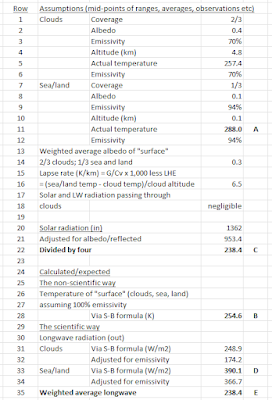Below is my list of assumptions and summary workings in case anybody want to check. This is all the coherent bits of actual information and proper phsyics that I have pieced together from blogs and articles by 'Climate Scientists'. They can't deny that they have said all this, although they do when it suits them.
To sum up, the very cornerstones of Climate Science are two Diagonal Comparisons. They compare A and B instead of comparing C and E (see workings below). They also compare C with D, instead of comparing C with E.
A, B and D are either inaccurate, irrelevant or taken hopelessly out of context!
By analogy, for sure, you can compare women's current wages in the UK with men's current wages for similar work, that means something. If there is a difference, it needs explaining and maybe action needs to be take to level up. Don't compare nominal women office workers' wages in 1982, not adjusted for inflation, with Premier League footballer wages in 2022. That is a Diagonal Comparison and of no relevance to anything.
1. Actual average temperature of the ocean and land surface is 288K (A, line 11). Accepted as correct for sake of argument.
2. If you calculate the 'effective temperature' (= expected temperature) of Earth's "surface" the non-scientific way, you get 255K (B, line 28). Sure, but issues with the 255K are:
- you have to assume that clouds are at sea level, and/or
- clouds, oceans and land are all the same temperature, and/or
- clouds don't exist (even though their existence reduces albedo and hence reduces effective temp), and/or
- clouds, land and ocean have 100% emissivity, and/or
- there is no lapse rate, and/or
- without 'greenhouse gases' there would be no lapse rate, and/or
- without 'greenhouse gases' there would be less cloud cover and/or cloud altitude would be lower.
None of those assumptions is in any way correct, they are all reality-denying nonsense.
3. But that is how they 'prove' the existence of a 33 degree Greenhouse Effect. Having generated B out of thin air (the hypothetical effective temperature of "the surface" subject to all the caveats in 2. above) they compare it with A (the actual temperature of one element of "the surface", which is conceptually quite different) and say "Something must be causing this, oh, it must be Greenhouse Gases".
4. This is NOT how you work out 'effective temperature'. What you do is: take emissivity and topography/altitude into account of all the constituent parts (and ignore sea and land that is below clouds - there is separate more or less closed cycle for this) and work out what temperature all the constituent parts of the "surface" would have to be to emit as much LW radiation to space as they, in total, absorb from the Sun*.
5. The calculation in 4. is a bit tricky, but it's easy enough working backwards from actual temperatures and emissivity of the constituent parts of "the surface"* to see if you get the 'right' amount of outgoing LW. This is the the scientific way. You find that clouds, sea and land are at the required temperature/altitude to emit the right amount of LW (E, line 35 - this is the same as absorbed incoming solar radiaton, C, line 22)*.
There is no discrepancy between actual temperatures and effective temperature. There is no 33 degree difference to explain away! Sea/land surface has to be warmer than expected to emit more LW than first expected to compensate for the fact that clouds have low emissivity and so emit less LW than first expected.
6. They then pluck another 'proof' out of the air that Greehouse Gases trap or block LW radiation. They compare upwelling LW from sea and land, assuming 100% emissivity (D, line 33) with C, line 22 and say "Look! GHG's are trapping or blocking 40% of outgoing LW. This is what is heating the planet.".
Nope. Two-thirds of that LW hits the underside of clouds and is either absorbed by the clouds or reflected back down. What gets to space is the weighted average of what clouds emit and what the cloud-free sea or land emits (E, line 35), which is exactly the same as incoming solar (C, line 22)*.
* Imagine a freshly made cake, yet to cool down that has just had cool icing applied. The main sponge part = sea or land. Two-thirds of the cake's surface is covered in cool icing = the clouds. Whatever heat exchange there is between the sponge and icing is irrelevant. For the cake to cool down, all that matters is the LW which is emitted by the exposed (non-iced) sponge and the icing. Including the LW radiation hypothetically emitted by the covered part of the sponge is insane and insanely stupid. "The surface" of this cake is two-thirds icing and one-third exposed sponge. So on Venus, the high temperature of the sponge (hard surface) is irrelevant as it is covered with a thick layer of icing (clouds). The temperature of the upper parts of the clouds is pretty much the same as the calculated effective temperature. There is a separate set of rultes to reconcile temperatures as between hard surface and clouds and there is no 'Greenhouse effect', let alone a 'runaway Greenhouse Effect'.

